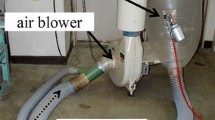Abstract
An intumescent fire retardant coating can effectively control fire spread and damage. Its dual purpose is to confine the surface spread of flame to the boundaries of an already established fire, and to retard the penetration of heat and flame to and through the coated surface. Our composition expanded and provided an insulation layer between the flame source and the combustion substrate, and liberated a quantity of primarily non-flammable decomposition products which tended to extinguish the flame. The main ingredients of the coating were cellulose acetate butyrate and HMDI (Desmodur N) for Polyurethane, and Chlorowax-70 (chlorinated paraffins) as fire retardant component. This fire retardant coating was applied to wood panels, and tested in a 2-foot tunnel, its flame spread rating being measured. The effects of three parameters of interest were investigated: the type of wood used, the percentage of Chlorowax, and the coating thickness. It was found of interest to study the oxidation of the coating using different techniques, e.g. flash pyrolysis under oxygen and GC/MS for analysis of the decomposed products. Combustion studies of the coating were also conducted using DSC and thermogravimetry, either with the scanning mode or under isothermal conditions. Comparisons were made between the results obtained from pyrolysis and combustion.
Zusammenfassung
Ein schwellender feuerhemmender Überzug kann Ausbreitung und Schäden von Feuer wirksam einschränken und wird zwei Zwecken gerecht: Verhinderung der Ausbreitung von ausgebrochenem Feuer und Schutz der überzogenen Oberfläche vor Hitze- und direkter Flammeneinwirkung. Die beschriebene Komposition quillt und bildet eine Isolationsschicht zwischen der Flammenquelle und dem brennbaren Material, liefert zugleich aber auch eine gewisse Menge von nichtbrennbaren, die Flamme erstickenden primären Zersetzungsprodukten. Die Hauptbestandteile des Überzugs sind Celluloseacetat und -butyrat und HMDI (Desmodur N) für Polyurethan sowie Chlorowax-70 (chlorierte Paraffine) als feuerhemmende Komponente. Dieser feuerhemmende Überzug wurde auf Holzplatten aufgebracht und in einem 2ft-Tunnel getestet, wobei die Flammenausbreitungsgeschwindigkeit gemessen wurde. Der Einfluß von drei interessierenden Parametern wurde untersucht: Typ des benutzten Holzes, Anteil von Chlorowax und Überzugsschichtdicke. Es erwies sich als interessant, die Oxydation des Überzugmaterials mit verschiedenen Techniken zu untersuchen, z.B. durch Schnellpyrolyse und Analyse der Zersetzungsprodukte mittels GC/MS. Verbrennungsuntersuchungen des Überzugmaterials wurden auch mittels DSC und Thermogravimetrie entweder nach der scanning-Arbeitsweise oder unter isothermen Bedingungen ausgeführt. Die bei Pyrolyse und Verbrennung erhaltenen Ergebnisse werden miteinander verglichen.
Резюме
Вспучивание огнесто йких покрытий может служить эффективным контролем распространения пла мени и вызываемых им п овреждений. Во-первых, такое вспуч ивание ограничивает поверх ность распространен ия пламени к границам уже установ ившегося пламени, а во вторых — з адерживает проникно вение тепла и пламени к покрытой п оверхности и через нее. Предложен ный авторами состав п окрытия обеспечивал и расшир ял изолирующий слой меж ду источником пламен и и горящим субстратом, а выделяю щееся количество первичны х невоспламеняющихс я продуктов разложения вызывало гашение пламени. Главными ком понентами покрытий я влялись ацетат- и бутират целл юлозы и ХМДИ (Десмодур Н) для по лиуретана и Хлоровак с (хлорированные параф ины) в качестве замедлителя пламени. Такое покрытие было использовано на дере вянных панелях и испы тано в двухфутовом тоннел е, где была измерена ск орость распространения пла мени. При этом исследовано влияние трех парамет ров: тип используемого дерев а, процент хлоровакса и толщина покрытия. Из учено окисление покр ытия с использованием разл ичных методов, как, например, пламенный пиролиз в а тмосфере кислорода с последую щим газхроматографи ческим и масс-спектроскопич еским анализом проду ктов разложения. Исследов ание процесса горения пок рытия было проведено методом ДСК и термогравиметрии со сканированием или же в изотермических у словиях. Проведено сопоставл ение результатов, полученных методом п иролиза и горения.
Similar content being viewed by others
References
V. M. Bhatnagar, in Fire Retardant Formulations, Technomic Publishing Co., Westport, 1972.
V. M. Bhatnagar, in Advance in Fire Retardants, Technomic Publishing Co., Westport, 1973.
V. M. Bhatnagar and J. M. Vergnaud, Fire Safety J., 4 (1982) 163.
V. M. Bhatnagar and J. M. Vergnaud, Paintindia, 32 (1982) 3.
H. Miller, Mater. Res. Stand., 8 (1969) 9.
Author information
Authors and Affiliations
Rights and permissions
About this article
Cite this article
Bhatnagar, V.M., David, J.C., Vergnaud, J.M. et al. Study of the combustion of a fire retardant coating by thermal analysis and different complementary techniques. Journal of Thermal Analysis 30, 467–478 (1985). https://doi.org/10.1007/BF02156511
Received:
Revised:
Issue Date:
DOI: https://doi.org/10.1007/BF02156511




